LINKS
Life Without Limbs
Nick Vujicic
Lynda Randle
Ministries
Windows of Hope
Gospel for Asia
Highway of Tears
Bill Gaither Ministries
Click
on
Pictures
To Enlarge
Go to
NASA
Website
For Description









The 'Terrible Twos'

Aglo




God's
Perfect
Sight
|
|
Young
Stars Sculpt Gas with Powerful Outflows in the Small
Magellanic Cloud
This is a Hubble
Space Telescope view of one of the most dynamic and
intricately detailed star-forming regions in space,
located 210,000 light-years away in the Small Magellanic
Cloud (SMC), a satellite galaxy of our Milky Way. At the
center of the region is a brilliant star cluster called
NGC 346. A dramatic structure of arched, ragged
filaments with a distinct ridge surrounds the cluster.
A torrent of radiation from the cluster's hot stars eats
into denser areas creating a fantasy sculpture of dust
and gas. The dark, intricately beaded edge of the ridge,
seen in silhouette by Hubble, is particularly dramatic.
It contains several small dust globules that point back
towards the central cluster, like windsocks caught in a
gale.
Energetic outflows and radiation from hot young stars
are eroding the dense outer portions of the star-forming
region, formally known as N66, exposing new stellar
nurseries. The diffuse fringes of the nebula prevent the
energetic outflows from streaming directly away from the
cluster, leaving instead a trail of filaments marking
the swirling path of the outflows.
The NGC 346 cluster, at the center of this Hubble image,
is resolved into at least three sub-clusters and
collectively contains dozens of hot, blue, high-mass
stars, more than half of the known high-mass stars in
the entire SMC galaxy. A myriad of smaller, compact
clusters is also visible throughout the region.
Some of these mini-clusters appear to be embedded in
dust and nebulosity, and are sites of recent or ongoing
star formation. Much of the starlight from these
clusters is reddened by local dust concentrations that
are the remnants of the original molecular cloud that
collapsed to form N66.
An international team of astronomers, led by Dr.
Antonella Nota of the Space Telescope Science
Institute/European Space Agency in Baltimore, has been
studying the Hubble data. In an upcoming issue of
Astrophysical Journal Letters the team reports the
discovery of a rich population of infant stars scattered
around the young cluster NGC 346. These stars are likely
to have formed 3 to 5 million years ago, together with
the other stars in the NGC 346 cluster. These infant
stars are particularly interesting as they have not yet
contracted to the point where their interiors are hot
enough to convert hydrogen to helium.
The Small and Large Magellanic Clouds are diffuse
irregular galaxies visible to the naked eye in the
southern hemisphere. They are two smallish satellite
galaxies that orbit our own Milky Way Galaxy on a long
slow journey inwards towards a future union with the
Milky Way. Hubble has resolved many star formation
regions in both of these neighboring galaxies that
provide astronomers with laboratories other than our own
Milky Way Galaxy to study how young stars interact with
and shape their environments. The two satellites are
named after the Portuguese seafarer Ferdinand Magellan
(1480-1521) who sailed from Europe to Asia and is best
known as the first person to lead an expedition to
circumnavigate the globe.
This image of NGC 346 and its surrounding star formation
region was taken with Hubble's Advanced Camera for
Surveys in July 2004. Two broadband filters that
contribute starlight from visible and near-infrared
wavelengths (shown in blue and green, respectively) have
been combined with light from the nebulosity that has
passed though a narrow-band hydrogen-alpha filter (shown
in red).
For more information, please contact: Antonella Nota,
Space Telescope Science Institute/ESA, 3700 San Martin
Drive, Baltimore, Md., (phone) 410-338-4520, (e-mail)
nota@stsci.edu, or
Marco Sirianni, Space Telescope Science Institute/ESA,
3700 San Martin Drive, Baltimore, Md., (phone)
410-338-4810, (e-mail) sirianni@stsci.edu, or
Lars Lindberg Christensen, Hubble European Space Agency
Information Center, Garching, Germany, (phone)
+49-(0)89-3200-6306, (cell) +49-(0)173-3872-621,
(e-mail) lars@eso.org, or
Ray Villard, Space Telescope Science Institute,
Baltimore, Md., (phone) 410-338-4514, (e-mail)
villard@stsci.edu
A Cosmic Holiday Ornament, Hubble-Style
'Tis the season for holiday decorating and
tree-trimming. Not to be left out, astronomers using
NASA's Hubble Space Telescope have photographed a
festive-looking nearby planetary nebula called NGC 5189.
The intricate structure of this bright gaseous nebula
resembles a glass-blown holiday ornament with a glowing
ribbon entwined.
Planetary nebulae represent the final brief stage in the
life of a medium-sized star like our Sun. While
consuming the last of the fuel in its core, the dying
star expels a large portion of its outer envelope. This
material then becomes heated by the radiation from the
stellar remnant and radiates, producing glowing clouds
of gas that can show complex structures, as the ejection
of mass from the star is uneven in both time and
direction.
A spectacular example of this beautiful complexity is
seen in the bluish lobes of NGC 5189. Most of the nebula
is knotty and filamentary in its structure. As a result
of the mass-loss process, the planetary nebula has been
created with two nested structures, tilted with respect
to each other, that expand away from the center in
different directions.
This double bipolar or quadrupolar structure could be
explained by the presence of a binary companion orbiting
the central star and influencing the pattern of mass
ejection during its nebula-producing death throes. The
remnant of the central star, having lost much of its
mass, now lives its final days as a white dwarf.
However, there is no visual candidate for the possible
companion.
The bright golden ring that twists and tilts through the
image is made up of a large collection of radial
filaments and cometary knots. These are usually formed
by the combined action of photo-ionizing radiation and
stellar winds.
This image was taken with Hubble's Wide Field Camera 3
on July 6, 2012, in filters tuned to the specific colors
of fluorescing sulfur, hydrogen, and oxygen atoms. Broad
filters in the visible and near-infrared were used to
capture the star colors.
Starry-Eyed Hubble Celebrates 20 Years of Awe
and Discovery
Looking like an apparition rising from whitecaps of
interstellar foam, the iconic Horsehead Nebula has
graced astronomy books ever since its discovery over a
century ago. The nebula is a favorite target for amateur
and professional astronomers.In this new Hubble Space
Telescope view, the nebula appears in a new light, as
seen in infrared wavelengths. The nebula, shadowy in
optical light, appears transparent and ethereal when
seen in the infrared, represented here with visible
shades. The rich tapestry of the Horsehead Nebula pops
out against the backdrop of Milky Way stars and distant
galaxies that are easily seen in infrared light.The
Horsehead was photographed in celebration of the 23rd
anniversary of the launch of Hubble aboard the space
shuttle Discovery. Over its two decades of producing
ground-breaking science, Hubble has benefited from a
slew of upgrades, including the 2009 addition of a new
imaging workhorse: the high-resolution Wide Field Camera
3 that was used to take this portrait of the Horsehead.
The backlit wisps along the Horsehead's upper ridge are
being illuminated by Sigma Orionis, a young five-star
system just off the top of the Hubble image. A harsh
ultraviolet glare from one of these bright stars is
slowly evaporating the nebula. Along the nebula's top
ridge, two fledgling stars peek out from their
now-exposed nurseries.
Gas clouds surrounding the Horsehead have already
dissipated, but the tip of the jutting pillar contains a
slightly higher density of hydrogen and helium, laced
with dust. This casts a shadow that protects material
behind it from being photo-evaporated, and a pillar
structure forms. Astronomers estimate that the Horsehead
formation has about five million years left before it
too disintegrates.
The Horsehead Nebula is part of a much larger complex in
the constellation Orion. Known collectively as the Orion
Molecular Cloud, it also houses other famous objects
such as the Great Orion Nebula (M42), the Flame Nebula,
and Barnard's Loop. At about 1,500 light-years away,
this complex is one of the nearest and most easily
photographed regions in which massive stars are being
formed.
Hubble's pairing of infrared sensitivity and
unparalleled resolution offers a tantalizing hint of
what the upcoming James Webb Space Telescope, set for
launch in 2018, will be able to do.
Hubble Zooms in on Shrapnel from an Exploded
Star
NASA's Hubble Space Telescope has unveiled in stunning
detail a small section of the expanding remains of a
massive star that exploded about 8,000 years ago.
Called the Veil Nebula, the debris is one of the
best-known supernova remnants, deriving its name from
its delicate, draped filamentary structures. The entire
nebula is 110 light-years across, covering six full
moons on the sky as seen from Earth, and resides about
2,100 light-years away in the constellation Cygnus, the
Swan.
This view is a mosaic of six Hubble pictures of a small
area roughly two light-years across, covering only a
tiny fraction of the nebula's vast structure.
This close-up look unveils wisps of gas, which are all
that remain of what was once a star 20 times more
massive than our sun. The fast-moving blast wave from
the ancient explosion is plowing into a wall of cool,
denser interstellar gas, emitting light. The nebula lies
along the edge of a large bubble of low-density gas that
was blown into space by the dying star prior to its
self-detonation.
The image shows an incredible array of structures and
detail from the collision between the blast wave and the
gas and dust that make up the cavity wall. The nebula
resembles a crumpled bed sheet viewed from the side. The
bright regions are where the shock wave is encountering
relatively dense material or where the "bed sheet"
ripples are viewed edge on.
In this image, red corresponds to the glow of hydrogen,
green from sulfur, and blue from oxygen. The bluish
features, outlining the cavity wall, appear smooth and
arched in comparison to the fluffy green and red
structures. The red glow is from cooler gas that was
excited by the shock collision at an earlier time and
has subsequently diffused into a more chaotic structure.
A few thin, crisp-looking, red filaments arise after gas
is swept into the shock wave at speeds of nearly 1
million miles an hour, so fast that it could travel from
Earth to the moon in 15 minutes.
Astronomers are comparing these new images to images
taken by Hubble in 1997. This comparison allows
scientists to study how the nebula has expanded since it
was photographed over 18 years ago
A Giant Hubble Mosaic of the Crab Nebula

This composite image of the Crab Nebula uses data from
three of NASA's Great Observatories. The Chandra X-ray
image is shown in light blue, the Hubble Space Telescope
optical images are in green and dark blue, and the
Spitzer Space Telescope's infrared image is in red. The
size of the X-ray image is smaller than the others
because the outwardly streaming higher-energy electrons
emitting X-ray light radiate away their energy more
quickly than the lower-energy electrons emitting optical
and infrared light. The neutron star, which has the mass
equivalent to the sun crammed into a rapidly spinning
ball of neutrons twelve miles across, is the bright
white dot in the center of the image.
Little Gem Nebula
This
colorful bubble is a planetary nebula called NGC 6818,
also known as the Little Gem Nebula. It is located in
the constellation of Sagittarius (The Archer), roughly
6,000 light-years away from us. The rich glow of the
cloud is just over half a light-year across — humongous
compared to its tiny central star — but still a little
gem on a cosmic scale.
When stars like the sun
enter "retirement," they shed their outer layers into
space to create glowing clouds of gas called planetary
nebulae. This ejection of mass is uneven, and planetary
nebulae can have very complex shapes. NGC 6818 shows
knotty filament-like structures and distinct layers of
material, with a bright and enclosed central bubble
surrounded by a larger, more diffuse cloud.
Scientists believe that the
stellar wind from the central star propels the
outflowing material, sculpting the elongated shape of
NGC 6818. As this fast wind smashes through the
slower-moving cloud it creates particularly bright
blowouts at the bubble’s outer layers.
Hubble previously imaged
this nebula back in 1997 with its Wide Field Planetary
Camera 2, using a mix of filters that highlighted
emission from ionized oxygen and hydrogen. This image,
while from the same camera, uses different filters to
reveal a different view of the nebula.
Image credit:
ESA/Hubble & NASA, Acknowledgement: Judy Schmidt
Text credit: European Space
Agency
|
Stormy Seas in
Sagittarius

Some of the most breathtaking
views in the Universe are created by nebulae — hot,
glowing clouds of gas. This new NASA/ESA Hubble Space
Telescope image shows the center of the Lagoon Nebula,
an object with a deceptively tranquil name, in the
constellation of Sagittarius. The region is filled with
intense winds from hot stars, churning funnels of gas,
and energetic star formation, all embedded within an
intricate haze of gas and pitch-dark dust.
Image Credit: NASA, ESA, J.
Trauger (Jet Propulson Laboratory)
Last Updated: Aug. 6, 2015
Editor: Sarah Loff
|
Lonely Galaxy
Lost in Space
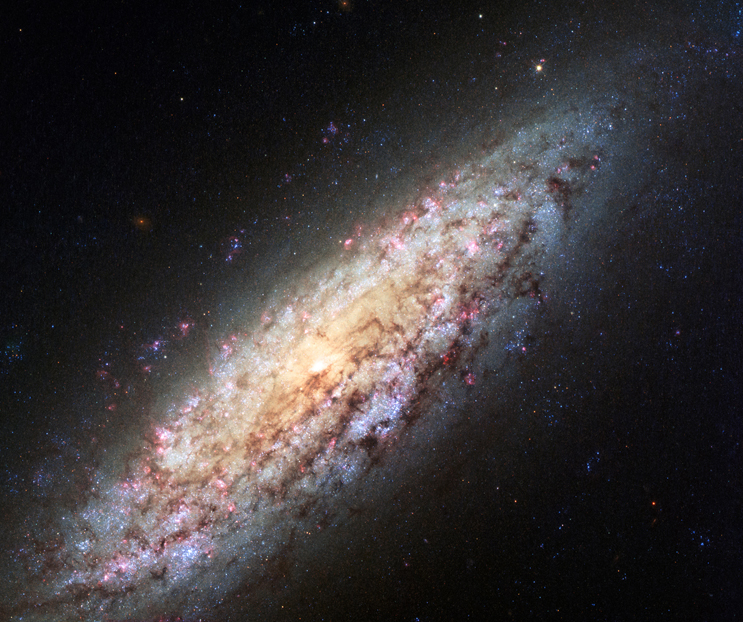
Most galaxies are clumped
together in groups or clusters. A neighboring galaxy is
never far away. But this galaxy, known as NGC 6503, has
found itself in a lonely position, at the edge of a
strangely empty patch of space called the Local Void.
The Local Void is a huge
stretch of space that is at least 150 million
light-years across. It seems completely empty of stars
or galaxies. The galaxy’s odd location on the edge of
this never-land led stargazer Stephen James O’Meara to
dub it the “Lost-In-Space galaxy” in his 2007 book,
Hidden Treasures.
NGC 6503 is 18 million
light-years away from us in the northern circumpolar
constellation of Draco. NGC 6503 spans some 30,000
light-years, about a third of the size of the Milky Way.
This Hubble Space Telescope
image shows NGC 6503 in striking detail and with a rich
set of colors. Bright red patches of gas can be seen
scattered through its swirling spiral arms, mixed with
bright blue regions that contain newly forming stars.
Dark brown dust lanes snake across the galaxy’s bright
arms and center, giving it a mottled appearance.
The Hubble Advanced Camera
for Surveys data for NGC 6503 were taken in April 2003,
and the Wide Field Camera 3 data were taken in August
2013.
The Hubble Space Telescope
is a project of international cooperation between NASA
and the European Space Agency. NASA’s Goddard Space
Flight Center in Greenbelt, Maryland, manages the
telescope. The Space Telescope Science Institute (STScI)
in Baltimore conducts Hubble science operations. STScI
is operated for NASA by the Association of Universities
for Research in Astronomy, Inc., in Washington, D.C.
Photo Credit: NASA, ESA,
D. Calzetti (University of Massachusetts), H. Ford
(Johns Hopkins University), and the Hubble Heritage Team
For images and more information about the Hubble Space
Telescope, visit:
http://www.nasa.gov/hubble
or
http://hubblesite.org/news/2015/23
Last Updated: July 30, 2015
Editor: Lynn Jenner
|
 God's
Perfect
Sight
God's
Perfect
Sight


|
LINKS
World Renew
Mennonite Central
Committee
Click
on Pictures
To Enlarge
Go to
NASA
Website
For Description

A Classic Beauty





Timeless Beauty


Cosmic Zoom Lens

Snowflakes in the
Universal Sky

Ghost Head Nebula




God's
Perfect
Sight

|















 God's
Perfect
Sight
God's
Perfect
Sight

